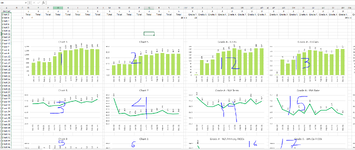BuJay
Board Regular
- Joined
- Jun 24, 2020
- Messages
- 73
- Office Version
- 365
- 2019
- 2016
- 2013
- Platform
- Windows
I thought I asked this question here but I can't find it....
I have a macro that examines charts in columns D through T, and then W through AM, and this continues until columns JJ through JZ. There are 15 groups of charts.
The code below lists the charts from upper left to lower right in columns D throgh T....then it lists out the charts from upper left to lower right in columns W through AM, and so on....
The code works....but it is EXTREMELY slow....does anyone see anything here that could be adjusted to speed it up?
Thanks!
I have a macro that examines charts in columns D through T, and then W through AM, and this continues until columns JJ through JZ. There are 15 groups of charts.
The code below lists the charts from upper left to lower right in columns D throgh T....then it lists out the charts from upper left to lower right in columns W through AM, and so on....
The code works....but it is EXTREMELY slow....does anyone see anything here that could be adjusted to speed it up?
Thanks!
VBA Code:
Option Explicit
Sub list_charts()
Dim ws As Worksheet
Dim outputsh As Worksheet
Dim last_cell As Range
Dim oChartObj As Object
Dim area_to_examine As Range
Dim col As Long
Dim rw As Object
Dim cl As Object
Set ws = ThisWorkbook.Sheets("charts")
Set outputsh = ThisWorkbook.Sheets("charts")
Sheets("charts").Activate
outputsh.Range("A:A").ClearContents
outputsh.Range("A1") = "Output:"
If ws.ChartObjects.Count = 0 Then
outputsh.Range("A2") = "No charts found"
Exit Sub
End If
Debug.Print "Charts found: " & ws.ChartObjects.Count
Set last_cell = ws.Range("A1")
For Each oChartObj In ws.ChartObjects
With oChartObj
If .TopLeftCell.Row > last_cell.Row _
Then Set last_cell = ws.Cells(.TopLeftCell.Row, last_cell.Column)
If .TopLeftCell.Column > last_cell.Column _
Then Set last_cell = ws.Cells(last_cell.Row, .TopLeftCell.Column)
End With
Next
Debug.Print "Bounds of range: $A$1:" & last_cell.Address
'start with column 4 (D) and then jump 19 columns at a time
For col = 4 To last_cell.Column Step 19
Set area_to_examine = Range(Columns(col), Columns(col + 16))
Debug.Print "Examining: " & area_to_examine.Address
For Each rw In Intersect(area_to_examine, ws.Range("A1", last_cell.Address).Rows)
For Each cl In rw.Cells
For Each oChartObj In ws.ChartObjects
With oChartObj
If .TopLeftCell.Row = cl.Row And .TopLeftCell.Column = cl.Column Then
outputsh.Cells(outputsh.Rows.Count, "A").End(xlUp).Offset(1) = .Name
Debug.Print .Name
End If
End With
Next
Next
Next
Next
End Sub





